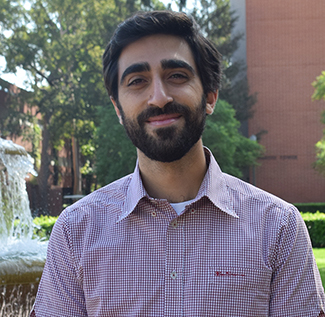
Impact in Profile: Manuk Avedikyan
2 min readSource: https://sfi.usc.edu/profiles/manuk-avedikyan
After spending three years studying and working in Armenia, Manuk Avedikyan is applying his passion for Armenian culture and history to USC Shoah Foundation’s new Armenian Genocide collection.
Avedikyan is currently working with program administrator Hrag Yedalian on indexing the collection, which launched in the Visual History Archive on April 24, 2015, the 100th anniversary of the Armenian Genocide. Ninety testimonies are already indexed and viewable in the archive; Avedikyan expects to finish indexing the remaining 300 by this spring.
Born and raised in Los Angeles, Avedikyan received a master’s in political science at the American University of Armenia and also worked at the Armenian Genocide Museum-Institute in Yerevan and Armenian newspapers. He also traveled across Armenia and Turkey conducting research on the Yazidis, a religious minority group.
He had moved back to Los Angeles to try to find work in local politics, but when he met Yedalian and found out about an open position working on USC Shoah Foundation’s Armenian Genocide testimony collection, he welcomed the opportunity.
Avedikyan is working with Yedalian and Visual History Archive curator Crispin Brooks to index the testimonies – assigning keywords to each minute of testimony using USC Shoah Foundation’s 63,000-keyword thesaurus. They often have to create new terms that have not been used in the Visual History Archive’s Holocaust, Rwandan or Nanjing collections before and come up with appropriate definitions. Avedikyan also had to learn how to use USC Shoah Foundation’s indexing software.
Avedikyan, a self-proclaimed “geography geek,” finds the work fascinating and insists on looking up each place the survivors mention in their testimonies on the map. His time living and traveling in Armenia and Turkey makes him feel a personal connection to the locations where the genocide took place – many of which he has actually visited himself.
“I feel much closer to [the testimonies] because I’ve been there. I’m really into where these villages are, where these towns are,” Avedikyan said. “If someone mentions a village I just cannot find [on a map], that’s when a geek gets really upset. Where is this place? But I usually find it.”
So far, Avedikyan is most intrigued by the collection’s Turkish-language testimonies. He hopes that one day USC Shoah Foundation can show these testimonies to people in Turkey; if Turks watch testimonies of genocide survivors speaking in their own language, who lived in their own village, they might feel a more personal connection to the genocide.
“It has this other aura. They’re average Armenians talking about their experience but I find those something special,” Avedikyan said.
He is also impressed by the testimonies of Yazidis, which he believes are the first audiovisual recordings ever taken of this group. Aesthetically, the videos are quite beautiful, he noted.
The Armenian Genocide collection can be a very powerful tool in Armenia’s fight for Turkish recognition of the genocide, Avedikyan said. The collection reminds him of an insight by Armenian author and lawyer Fethiye Çetin: that the individual stories of survivors cannot be disputed or politicized.
“Just discussing your own story could allow someone to be sympathetic with you and understand things better. And [testimony], because it’s all very personal, I think it allows for others to not only respect it but connect with it more,” he said. “You can’t politicize your personal story.”

